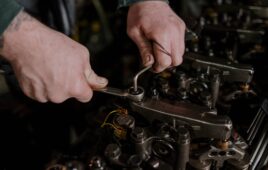For many years, engine manufacturers experienced major production set backs due to the failure of exhaust manifold joints. These components were typically subject to severe vibration, joint fatigue, and temperature extremes. When turbo mounting nuts shake loose and fall off, the engine fails and that leads to a range of major headaches.
Cummins Inc. found a way to secure exhaust manifold nuts when developing its Off-Highway Tier 3 QSX engine. According to Dale Gibby, Cummins mechanical development engineer, “Our industrial customers often rely on our engines for decades. Our goal was to design the QSX engine for rock-solid, real-world reliability in industrial applications ranging from farm tractors, road graders, rock crushers, generators, air compressors, and drill and concrete pumpers.”

The right fastener for robust applications can perform well and for long durations under harsh conditions.
To assure engine reliability in the field, Gibby focused on keeping the QSX engine’s exhaust manifold joints secure despite the harsh industrial field environment. Standard fasteners were less than satisfactory due to their susceptibility to vibration, thermal distortion, loosening due to thermal cycles, and wide variability in initial pre-load.
“We avoided adhesives and nylon plugs because the high temperatures involved would burn them off,” explained Gibby. “We also avoided split washers and deformed threads because their stress concentration is a big concern for fatigue failure. Split washers can cause more problems than they solve if they gouge surfaces and start fatigue cracks.”
A tall spacer and a tall cap screw can add stretch in the bolted joint, which can help in some joint applications, according to Gibby. But for many engines, including the QSX engine, there is not enough package or under-the-hood space for this approach so it was not an option.
Traditional locking fasteners do not address a basic design problem with the standard 60° thread form: that the gap between the crest of the male and female threads can lead to vibration-induced thread loosening. Stress concentration and fatigue at the first few engaged threads is also a problem, along with an increased probability of shear, especially in soft metals, due to its tendency toward axial loading. Temperature extremes can also expand or contract surfaces and materials, potentially compromising joint integrity.
Cummins engineers successfully addressed these challenges while reducing component weight and enabling re-usability with the Spiralock locking fastener. This re-engineered thread form adds a 30° wedge ramp at the root of the thread which mates with standard 60° male thread fasteners.
The wedge ramp allows the bolt to spin freely relative to female threads until clamp load is applied. The crests of the standard male thread form are drawn tightly against the wedge ramp, eliminating radial clearances and creating a continuous spiral line contact along the entire length of the thread engagement. This continuous line contact spreads the clamp force more evenly over all engaged threads, improving resistance to vibrational loosening, axial-torsional loading, joint fatigue, and temperature extremes.

Spiralock locking fasteners were tested alongside standard counterparts to determine strength, durability, and reliability.
Gibby pro-actively tested the Spiralock locking fastener, head-to-head against standard fasteners in an abusive, test-to-fail, thermal cycling test. The test compared how long typical stainless steel nuts versus Spiralock stainless steel nuts stayed securely fastened on the exhaust manifold joints of a QSX industrial engine. Four nuts each were tested with the Spiralock nuts silver plated for more consistent pre-load.
In addition, a warped, worn-out exhaust manifold was used with more than 1,250 hrs of thermal cycles, many gasket failures, and turbo removals. The engine ran an abusive thermal test, cycling from 400° F to 1400° F and back every six min. Besides the huge thermal swings, the engine ran past redline and at high idle, according to Gibby.
“In our test, we decided to stress the exhaust manifold joint fasteners much harder than any customer would in the field,” said Gibby. “The goal was to provide reliable industrial engine performance that gets the job done without unscheduled downtime.”
Because the test was designed to be real-world practical, all the nuts were significantly under-tightened to nominal load minus 3.5 sigma, a statistical measure of standard deviation.
Gibby added, “When an industrial engine fails in the field, mechanics rush to get it back in service and resume production, often while the engine and weather are hot. In those conditions, mechanics may not measure or fully torque exhaust manifold nuts. We wanted a fastener designed to reliably perform in the conditions our customers face.”
Under the vibration and extreme thermal cycles, three of the four typical stainless steel nuts became loose and fell off within two hours, leading to blown joints and a stopped engine. However, the Spiralock nuts never fell off and were still secure more than 18 hours after installation. Gibby concluded that the Spiralock locking fasteners will survive under-torqued installations where standard nuts would fail. The result is more reliable engine performance.
Spiralock
www.spiralock.com
Cummins, Inc.
www.cummins.com





Tell Us What You Think!